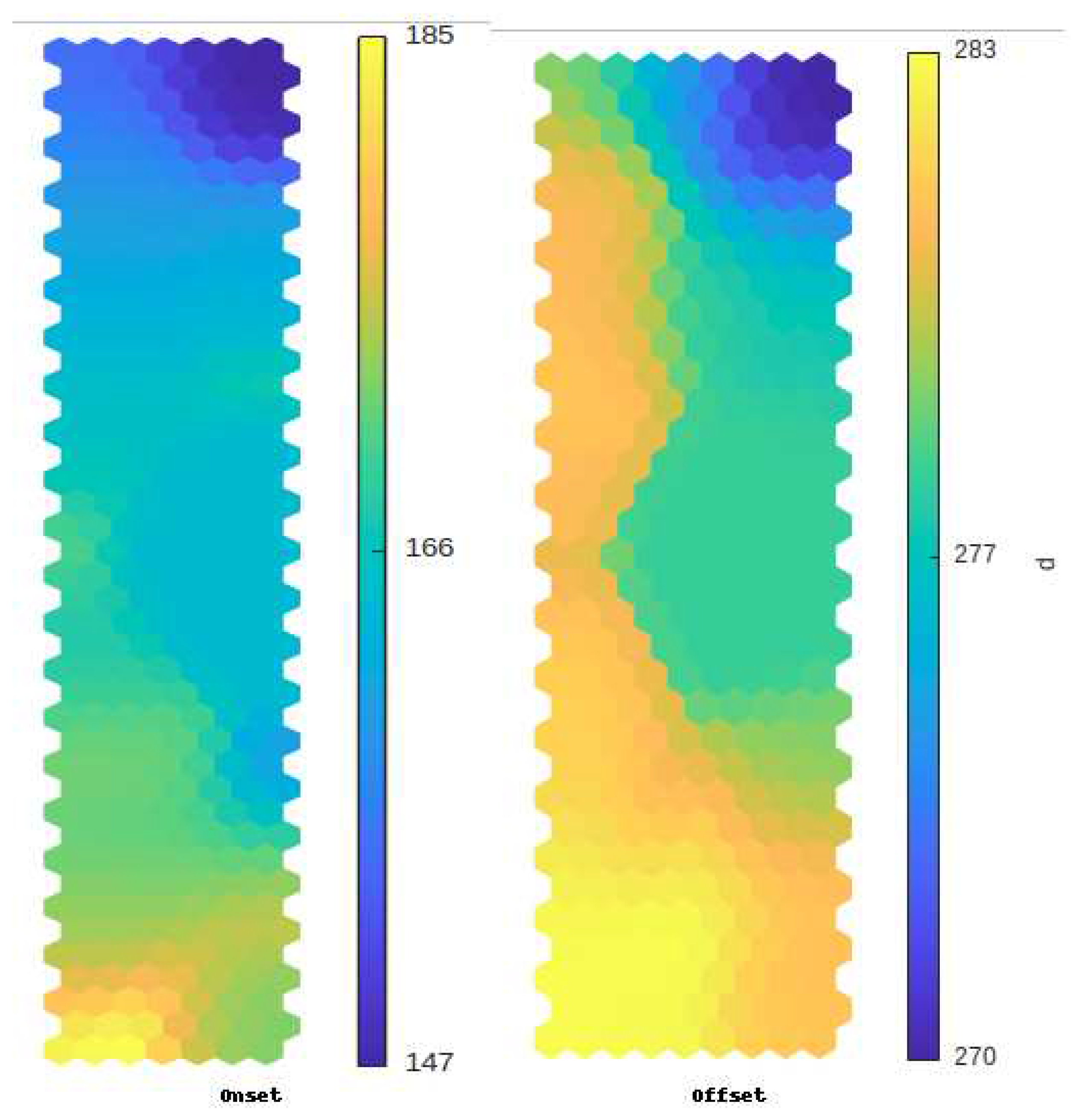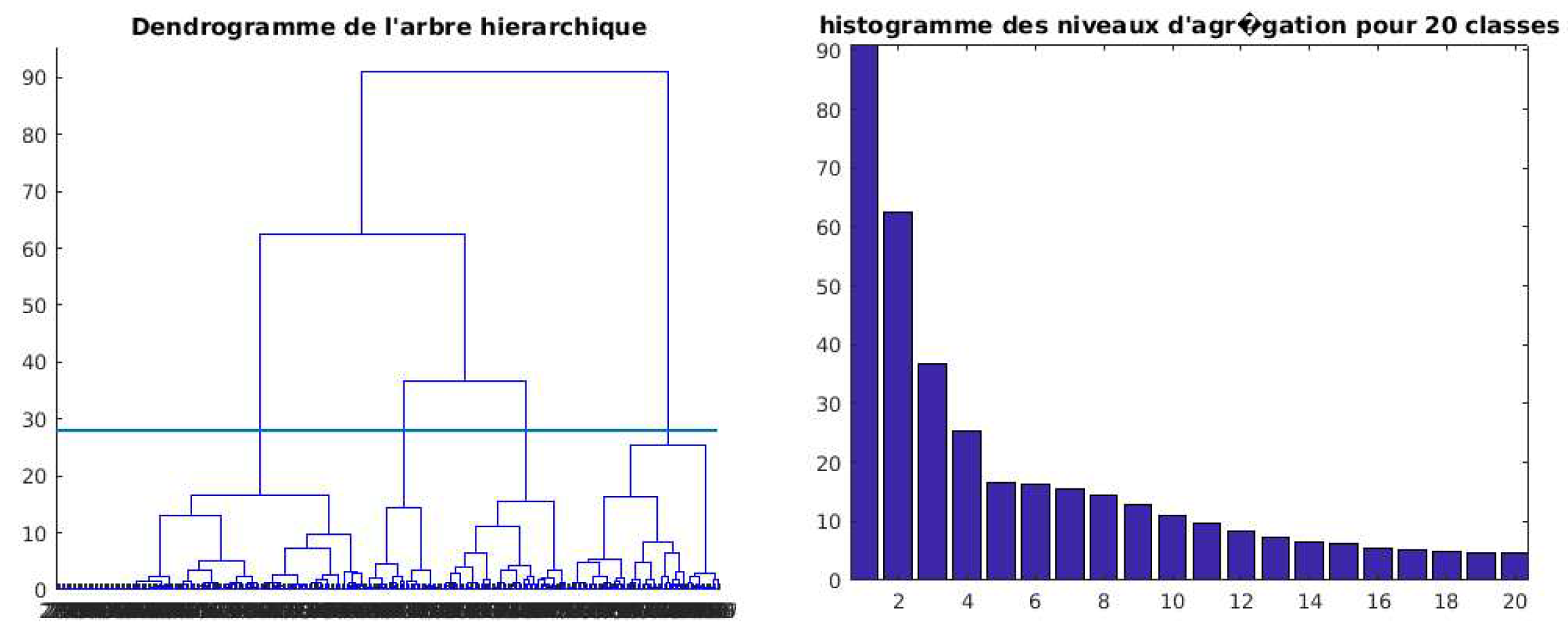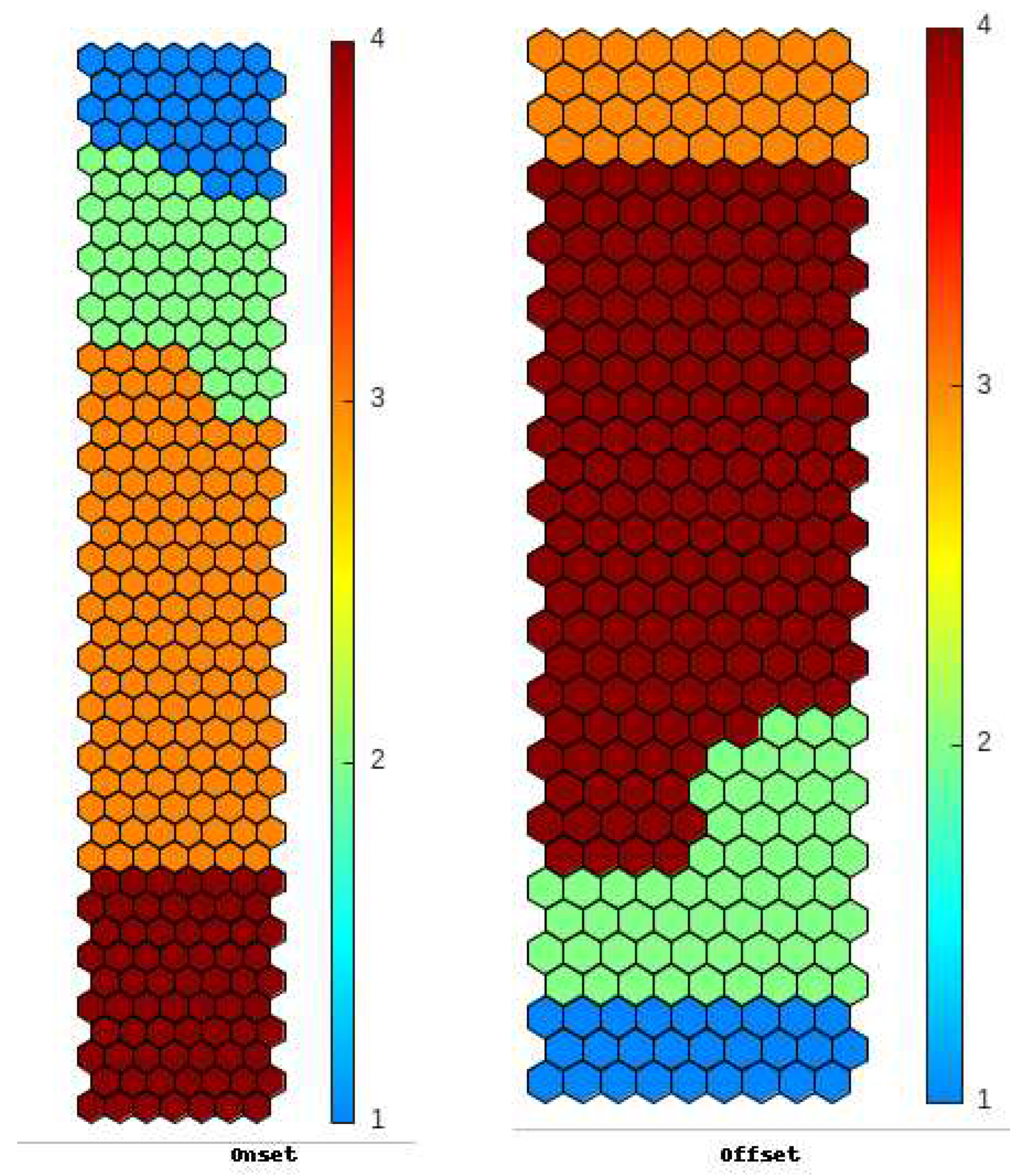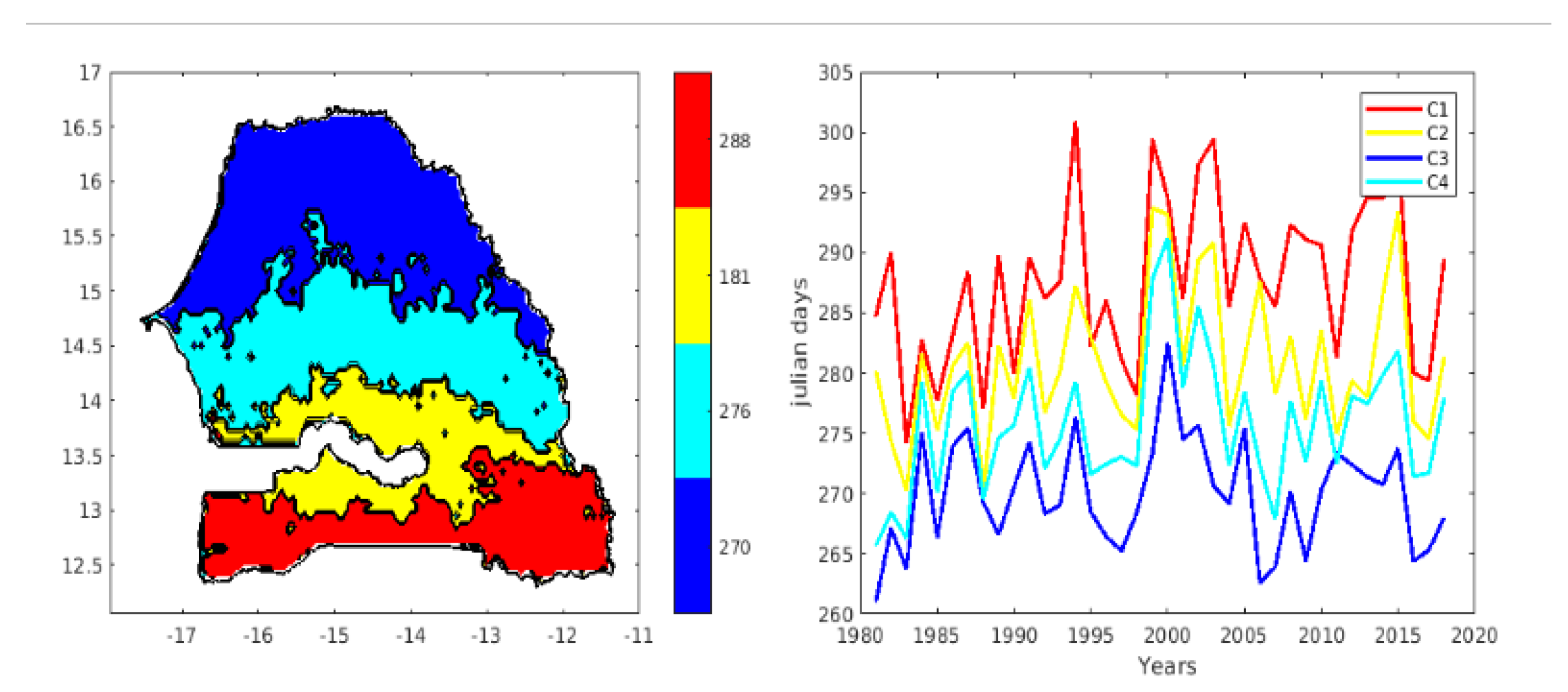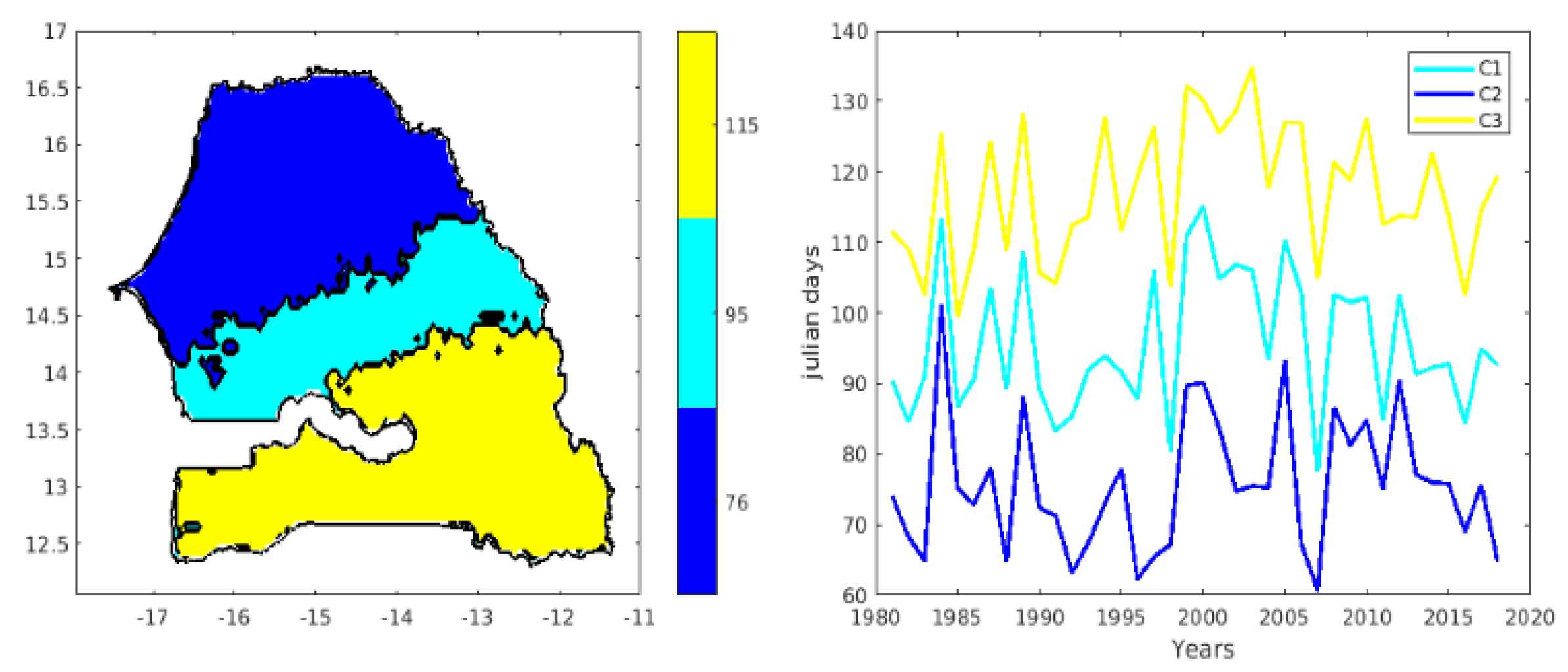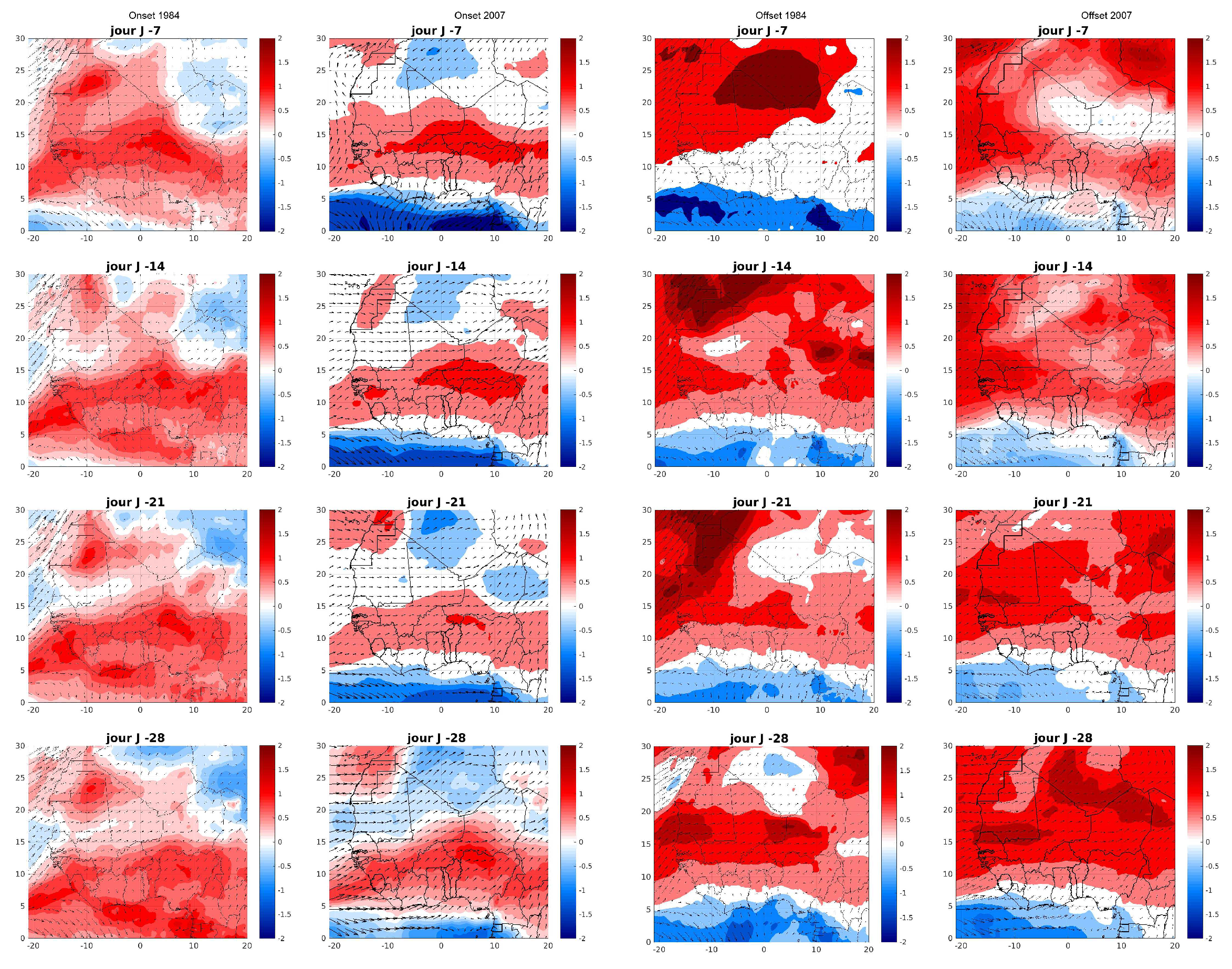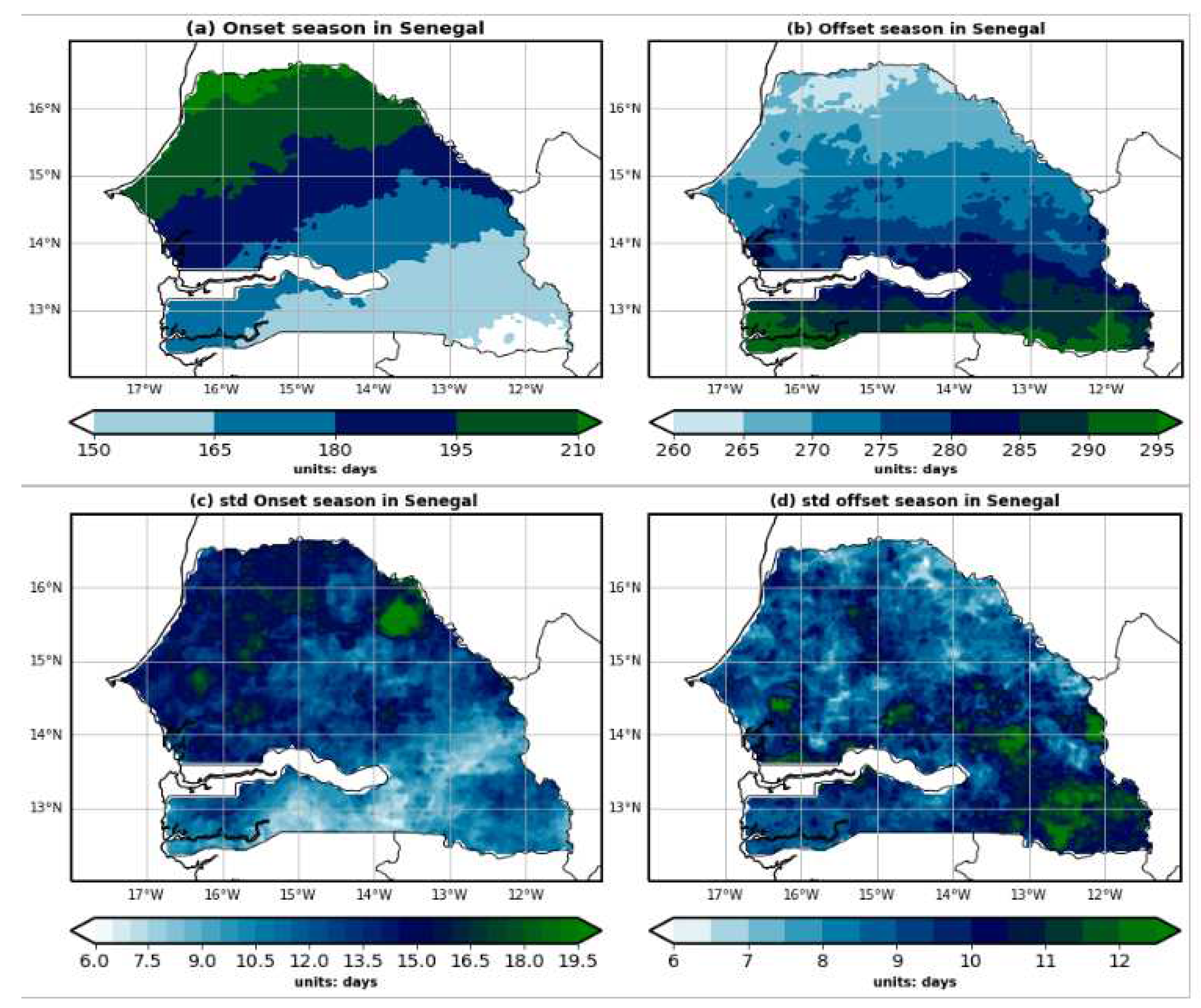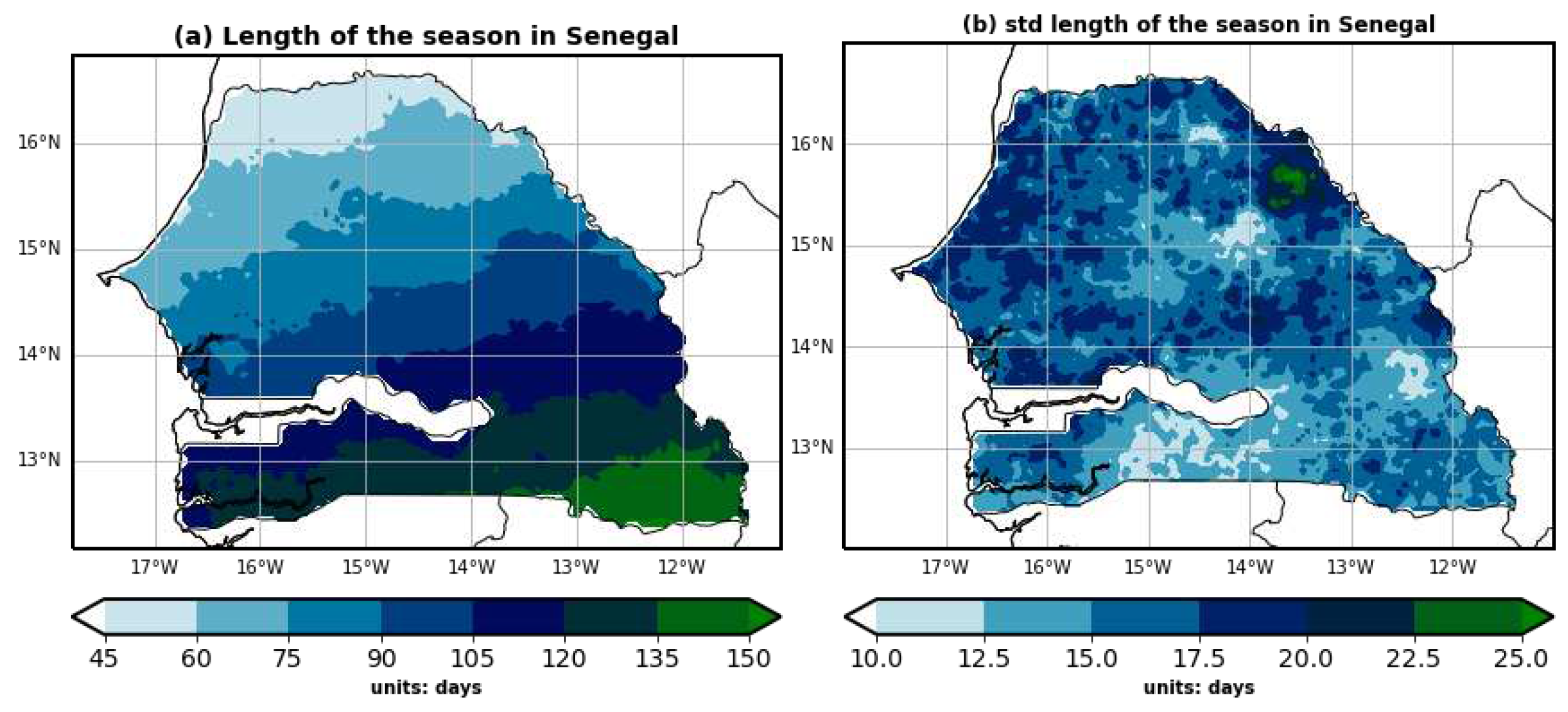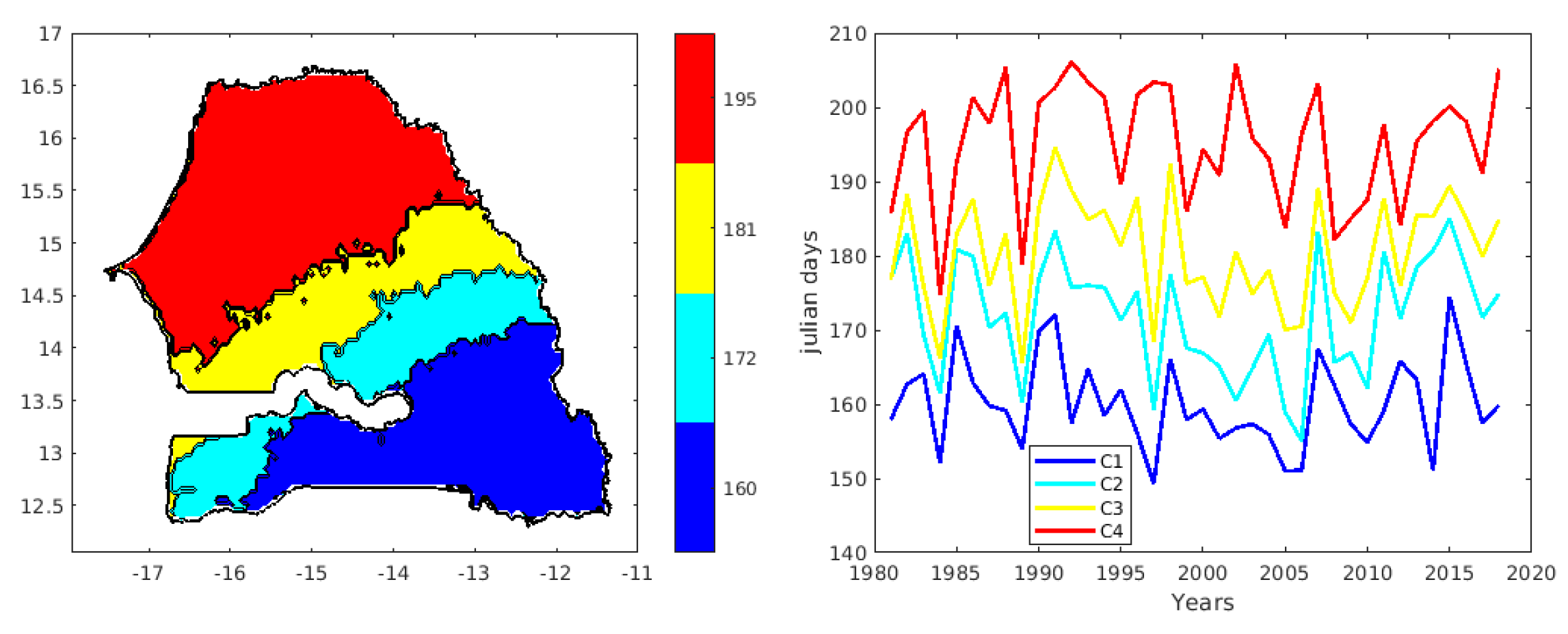3.1. Spatial variability of onset and cessation of the rainy season in Senegal
The rainy season in West Africa corresponds to the period when the main agricultural activities take place. In Senegal, as in other Sahelian countries, rainy season is highly variable temporarely and spatially . This spatio-temporal variability makes the selection of seed varieties and crop types difficult to plan.
Figure 1 below illustrates this spatio-temporal fluctuation in the onset dates of the rainy season in Senegal.
Figure 1a and 1b show the meridional gradients (from south to north) of the start and end of the rainy season in Senegal. The start and end of the rainy season exhibit a dual gradient in Senegal: a gradient oriented from southeast to northwest for the start of the season, and a gradient from south to north for the season end date. However, this gradient translates into increasingly late start dates going from southeast to northwest, and increasingly late end dates going from north to south. Indeed, the rainfall withdrawal begins first in the northern part of Senegal around September 17 to 27, then progressively from September 28 to October 7 towards the center, between latitudes 14° and 15° N. Thus, the end of the season is defined in a relatively symmetrical way with respect to the beginning, underlining the contradiction between the sudden onset of the monsoon and its gradual withdrawal. All this justifies that the latitudinal gradient of the start and end of the season, from south to north or from north to south, is consistent with the zonal structure of rainfall, associated with the seasonal progression of the Intertropical Convergence Zone (ITCZ). These results therefore correspond to the same latitudinal distribution of the West African summer monsoon, which is linked to a shift of the ITCZ from a quasi-stationary position at 5°N in May-June to another quasi-stationary position at 10°N in July-August ([
22]). This north-south gradient of start and end dates of the season is in perfect agreement with the results of [
2], who demonstrated that the spatial configurations of rainfall accumulation and intensity, as well as the onset, cessation dates and length of the season describe a clear gradient oriented from south to north. In addition, their studies confirmed the dual (south to north and southeast to northwest) gradient in Senegal. However, this meridional distribution of the beginning and end of the season is accompanied by a variability in the standard deviation (
Figure 3c, d), where the variation is between 6 and 19 days for the onset of the season and between 6 and 12 days for the offset of the season. The average onset date of the rainy season in Senegal is June 29, with a standard deviation of 6 days, meaning the season can start up to 6 days before or after the expected date. Similarly, the average end date of the season is October 4, with a standard deviation of about 5 days. These results corroborate the studies of [
23], who showed that in 80% of cases, the rainy season starts at the earliest during the second half of June and ends at the latest during the first half of October.
3.2. Spatial variability of the length of the rainy season (LRS) in Senegal
The duration of the rainy season varies from year to year and from place to place. This duration is calculated by taking the difference between the onset and cessation dates of the rainy season, as defined above. The spatial distribution of this duration in Senegal shows a north-south gradient, with a decrease in the duration of the season going from south to north (
Figure 2). This figure indicates that the duration of the rainy season in Senegal varies from 45 to 150 days (
Figure 2a), with a standard deviation ranging between approximately 10 and 25 days (
Figure 2b). Thus, the longer duration of the rainy season in southern and central Senegal indicates a higher probability of rainy days in this region, as well as significant rainfall accumulations. In addition, the extension of the rainy season in the south of the country can be attributed to an earlier onset and a later end compared to the north of the country. This difference in the duration of the rainy season between the north and south of the country can sometimes reach 105 days, which is in perfect agreement with the results of [
24].
The spatial variability in the length of the rainy season can have several implications. For example, the season length can impact water availability and agriculture in different regions of the country. A longer rainy season in southern and central Senegal suggests a higher probability of rainy days in this part of the country, as well as higher seasonal rainfall accumulations. This can be beneficial for agriculture and water supply, as greater precipitation can aid crop growth and recharge water resources. In addition, the extension of the rainy season in the south of the country, with an earlier onset and later end compared to the north of the country, can also present challenges. For example, a longer rainy season may increase the risk of flooding in some regions. Additionally, the variability in the rainy season can affect agricultural planning and planting schedules, as farmers must account for these variations to optimize yields. Therefore, this duration of the rainy season is of considerable interest for planning agricultural activities. Indeed, in order to minimize the risks associated with late starts and early ends to the rainy season, Senegalese farmers can adjust their farming activities to occur between the second half of July and the first half of October. However, it should be noted that the shortening of the rainy season is exacerbated by the dry spells that frequently occur during the rainy season ([
1,
25,
26]).
After identifying spatial variations in the start, end, and duration of the rainy season, we then established, for each region of Senegal, the expected period for the start and end of the rainy season.
3.3. Prediction of the onset and offset in Senegal by Kohonen maps
To classify the onset and cessation phases of rain in Senegal, we used CHIRPS precipitation data. We extracted the Senegalese area, with longitude coordinates (-18, -11) and latitude coordinates (11, 17) and a spatial resolution of 0.05° x 0.05°. We obtained annual average maps from 1981 to 2018, for a total of 38 years. Each year is made up of 14,000 pixels, or (100 * 140). To form the training dataset, we formed a dataset of 14,000 observations (pixels) and 38 variables (years). The Kohonen algorithm was applied to the database described above. Several SOM applications were carried out by varying the initialization parameters. The best map in terms of vector quantization was retained, and we finally obtained a map of 43 × 7, or 301 neurons for the Onset, and a map of 33 x 9, for a total of 297 neurons for the Offset. We then projected the pixels of the year 1984 onto the obtained Onset and Offset maps. The two figures show a good organization of the topology of the observations (pixels) on the map (
Figure 3). We note that the two maps are well organized, with the weak values at the top right of the map and the strong values at the bottom of the map. Given the large number of neurons in each map (301 neurons for the Onset and 297 neurons for the Offset), we grouped them into a smaller number of classes by applying a hierarchical agglomerative clustering (HAC) with the Ward criterion as the aggregation criterion for the neurons of the self-organizing map. Figure. 4 shows the dendrogram and histogram of the aggregation levels of the neurons in the Onset neuron map. Based on this figure, we chose 4 classes. The same work was done with the Offset map (Figure not shown) and we also retained 4 classes for the latter.
Figure 5: Representation of the 4 classes on the self-organizing map for onset (left) and offset (right). The color bar represents the class numbers. We note that for onset, class 3 corresponds to the neurons in the middle of the map, while class 4 corresponds to the neurons at the bottom of the map. However, for offset, the representation is different. We note that classes 1 and 2 correspond to the neurons at the bottom of the map, but the neurons at the top of the map correspond to class 3.
Figure 3.
Projection of the pixels of the years 1984 onto the self-organizing maps of the Onset and Offset.
Figure 3.
Projection of the pixels of the years 1984 onto the self-organizing maps of the Onset and Offset.
Figure 4.
Dendrogram (left) and histogram (right) of aggregation levels for 20 classes obtained from the hierarchical classification of neurons.
Figure 4.
Dendrogram (left) and histogram (right) of aggregation levels for 20 classes obtained from the hierarchical classification of neurons.
Figure 5.
Classification of neurons on the topological map: for onset (left) and for offset (right).
Figure 5.
Classification of neurons on the topological map: for onset (left) and for offset (right).
After classifying the neurons into different classes, we projected the data from each class onto the geographical map of Senegal. The left map in
Figure 6 shows the spatial distribution of the different onset phases of the season, averaged over the period 1981-2018. We observe a clear meridional gradient in the onset of the season, with later starts in the north of the country and earlier starts in the south. These results indicate that the start date of the season is aro, (255, 255, 255)und June 9 (day 160) in the southeastern regions of Senegal (blue on the map), extending to latitude 13°N in the eastern part of the country. Moving from the southeast towards the center of Senegal, the start dates of the season are expected around June 19 (day 172). In the north-central part of Senegal (yellow on the map), the start dates of the season are expected around June 27 (day 181). The northwestern part of Senegal (red on the map) is characterized by a start date of the season around July 11 (day 195). Examining the interannual variability averaged over each class over the period 1981-2018 (see Fig. 6 on the right), we observed start dates for the rainy season that were sometimes early (1984, 1997, 2005, and 2014) and sometimes late (1989, 1991, 2007, and 2015). An interannual irregularity in the start dates is observed across the different classes, as well as between the clusters. This difference between the clusters is due to the spatial variability of the seasonalities between the south and north of Senegal. In other words, this variability in the start can be explained by the climatic differences between these two zones (the south has a sub-Guinean climate and the north has a Sahelian climate). As with the spatial variability, we find that the interannual variability of the start of the season follows the south-north gradient. However, a weak south-north gradient is observed in some years, such as 1984 and 2007.
Figure 7 (right) shows the interannual variability of the end date of each class for the four classes obtained in Senegal. We note a weak meridional gradient in the end date of the season between the years 1984 to 1994 approximately and a strong meridional gradient between 1995 to 2018. Similarly to the start date, the cessation date also shows years with low variations between the north and south (for example 1984, 1985, 1986, etc.). Interannual variability within each class in Senegal over the period 1981-2018 (see Figure. 6 on the right) shows long seasons (class 3) and short seasons (class 2). An interannual irregularity in the lengths of seasons is observed across the different classes, as well as within each class (
Figure 8). We observe years with low variability in the length of the season (1984, 1989, 2007) and years with high variability in the length (1988, 1991, 2002, etc.). Years such as (2001, 2003, and even 2010) are marked by long rainy seasons and others such as (2007, 1994, 1992, etc.) are marked by short lengths of season (
Figure 8). This section is not mandatory, but can be added to the manuscript if the discussion is unusually long or complex.
Figure 7.
Prediction of the offset dates of the rainy Season in Senegal using Kohonen Neural Networks (Spatial End Classification on the left, and the time series of classes on the right).
Figure 7.
Prediction of the offset dates of the rainy Season in Senegal using Kohonen Neural Networks (Spatial End Classification on the left, and the time series of classes on the right).
Figure 8.
Spatial and temporal classification of the length of the rainy season in Senegal (1981-2018)
Figure 8.
Spatial and temporal classification of the length of the rainy season in Senegal (1981-2018)
Similar to the spatio-temporal variability of the start date, the spatio-temporal variability of the cessation dates and durations of the rainy season in Senegal can also be explained by the climatic differences between the south, which has a sub-Guinean climate, and the north, which has a Sahelian climate. After having classified the spatio-temporal variability of the start, end, and duration dates of the season, it is now interesting to analyze the intra-seasonal indices that can modulate these starts and ends (late and/or early) of the rainy season in Senegal.
3.4. Dynamic analysis
To better characterize the onset and cessation of the rainy season, the behavior of certain atmospheric parameters was analyzed for the years 1984 and 2007, particular years marked respectively by an early start and a late start on almost all of Senegalese territory. This analysis focused on a period of several weeks, or four weeks, preceding the dates of the start and end of the rainy season during these years. The transport of moisture plays a primary role in determining the characteristics of precipitation in West Africa, including Senegal, as shown by several studies ([
27,
28]). These complex meteorological phenomena are indeed influenced by atmospheric circulations, jet streams, air masses and ocean-atmosphere interactions ([
22,
29,
30]).
Figure 9 thus represents the weekly average of the surface-850 hPa integrated moisture transport, materialized by streamlines, and of the the surface-850 hPa integrated specific humidity over the same deph, represented by a color code during one, two, three and four weeks preceding the start and end dates of the rainy season in Senegal. It is found that the moisture transport that precedes the start of the rainy seasons (1984 and 2007) is oriented from the oceanic zones to the continental lands, and is crucial to start the rainy season. The moist winds carry water vapor from the ocean to the land, and when these moist air masses come into contact with the drier and warmer air above the land, condensation occurs, causing the formation of clouds and precipitation.
Figure 9 shows the integrated and specific humidity transport over West Africa during two rainy seasons, one early in 1994 and the other late in 2007. The two left columns show the humidity transport during the start of the rainy season, while the two right columns show the humidity transport during the cessation of the rainy season. The humidity transport is represented by streamlines, and the anomalies of the integrated specific humidity are shown by a color code. It is observed that the moisture transport preceding the onset of the rainy seasons (1994 and 2007) is oriented from the oceanic zones to the continental lands, and is crucial to initiate the rainy season. Moist winds carry water vapor from the ocean to the land, and when these moist air masses come into contact with the drier and warmer air above the land, condensation occurs, causing the formation of clouds and precipitation.
Figure 9.
Composite analysis of moisture transport and integrated specific humidity anomalies between 1000 and 850 hPa during weeks before the onset and offset of the rainy seasons of 1984 and 2007
Figure 9.
Composite analysis of moisture transport and integrated specific humidity anomalies between 1000 and 850 hPa during weeks before the onset and offset of the rainy seasons of 1984 and 2007
The two rainy seasons (1984 and 2007) are characterized by moisture fluxe from the Atlantic Ocean. However, there are significant differences between the two seasons. The moisture transport calculated for 1984 (a year with an early start of the rainy season) follows a southwest trajectory at latitudes above 5°N during the various forecast periods. A strong concentration of moisture is noted above the Atlantic Ocean, and a strong penetration of moisture into the continent. This configuration may be due to a high pressure system over the Atlantic and low pressure over the continent, which facilitated the transport of moisture to the continent ([
31,
32,
33]). In contrast, for 2007 (a year with a late start of the rainy season), the moisture transport adopts a west direction at latitudes above 5°N during the different lead times except for the 7-day lead time, where it adopts a south direction over the ocean. At latitudes below 5°N, the moisture transport is eastward over the ocean. The specific humidity anomalies for 1984 decrease from south to north. In other words, the moisture is stronger in the south and tends to decrease as it advances towards the northeast of the continent. We also note for 2007 that the Sahelian band to the ocean is much more humid than the south of West Africa and the Sahara in all lead times. In addition, it is noticed that the progression of moisture towards the continent and the north decreases with the delay. In other words, the moisture transport moves northward the closer we get to the start date of the season. However, the moisture transport has advanced much further northward in West Africa at the early start of the year 1984 compared to the year 2007, where there is a late start. Similarly, moisture transport plays a role in determining the end of the rainy season ([
22,
33]). As seasons change and air masses shift, moisture transport can diminish, leading to decreased rainfall. Factors like the retreat of monsoon systems and the shift of jet streams influence the amount of moisture available for precipitation. In Figure. 9, for the season end dates, the meridional gradient of specific humidity is still observed according to the different lead times. The two rainy seasons ended in a somewhat similar fashion, with high moisture concentrations over the continent’s North and low moisture concentrations in the South. It is observed that the high concentrations are pushed back northward over the continent as the end of the season approaches. The results seem to show that years with stronger moisture transport (e.g. 1984) can lead to earlier onsets of the rainy season and more abundant rainfall. Conversely, when moisture transport is weakened, the rainy season may be delayed (e.g. 2007) or precipitation may be less abundant.
